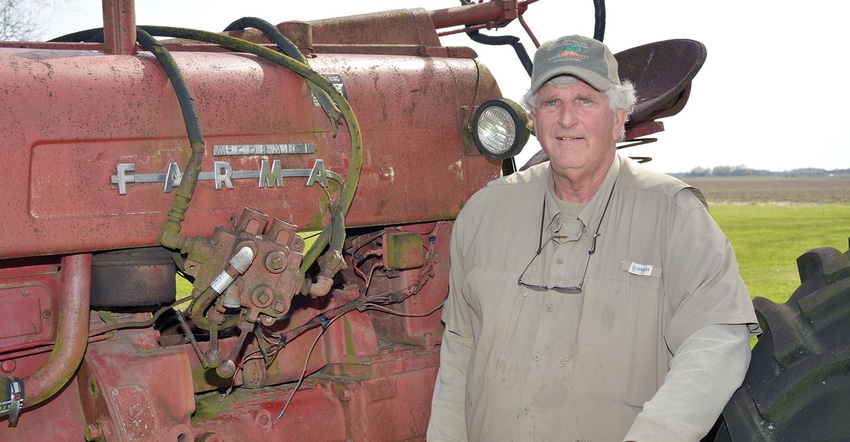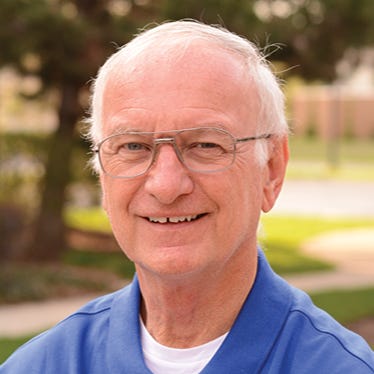
Pete Hunter claims to have retired from active farming at the end of 2016. He explains this as he takes calls from the two farmers that lease Stovall Farms and to whom he has offered “to help out.” Conversation around the kitchen table of his home place at Stovall Farms/Belmont Planting Co., near Clarksdale, Miss., is interrupted on several occasions from other calls regarding field work and his ongoing efforts with several conservation entities to which he devotes countless hours. We don’t mind.
His retirement hours look a lot like a fulltime job — with overtime.
He agreed to chat about changes he’s witnessed during his farming career, which began riding around with his father looking at crops.
“He took me everywhere,” Hunter says. He recalls a lot of two-cylinder tractors, old International M machines and a lot of 4-row and 6-row planters.
“I remember when some went to 8-row or 10-row planters in skip-row cotton,” he says. “I don’t go far enough back to remember when I saw the first cotton picker come in. I remember seeing one- and two-row pickers, and I remember seeing folks picking cotton by hand.”
Picked by hand
He says some producers with mechanical pickers still picked the ends by hand. “I picked some, myself, at the row ends, just for fun,” he recalls.
He says the old John Deere pickers had to be greased in the middle of the day. “If we greased them in the morning when it was cold, they wouldn’t pick.
“We didn’t have a lot of chemicals, until Treflan came along.” He recalls calibrating the equipment and putting the tractor in fourth gear and setting the pressure on 30 to apply it.
He says the big tractor on the farm was 125 horsepower. “We had no cabs. The good tractors had fenders, and if we were lucky, we had an umbrella for a top.”
He recalls using a flame cultivator. “I liked it,” he says, “because I didn’t have to get up as early.”
Flame cultivator
He says he had to wait until the dew was off the weeds before he could put the flame cultivator in the field. “I could get started about 8, sharpening sweeps for about two hours, and then go to the field. We always had to sharpen sweeps.”
He also recalls finding a moonshine still in a ditch bank.
Hunter says farm policy also has changed since he’s been farming. The biggest thing, he says, “It’s so partisan, now.”
He’s particularly concerned about conservation programs in new farm policy. Proposed “budget tightening” could mean programs get streamlined. He says two in particular, the Conservation Stewardship Program (CSP) and the Environmental Quality Incentive Program (EQIP) may be lumped together, possibly to the detriment of one or the other — maybe both.
“These programs are different,” he says. CSP is a program that enhances a farmer’s ongoing conservation practices and “offers an incentive payment for performance.” EQIP is a cost-sharing program that assists qualifying landowners in adding or improving a conservation practice on their land.
CSP acreage
Hunter says Mississippi landowners use the CSP option on a lot of acreage. He adds that CSP allows farmers to put conservation practices in places they might not ever consider. It encourages the use of conservation practices. He says he has used EQIP on a tailwater project that improves water conservation.
He adds that Mississippi is the No. 1 state in the nation for implementing conservation practices and is high on the list (fourth) for amount of funding received.
He also hopes conservation program changes initiated during the Obama administration that put more control at the federal level can be reversed. Administrative transformation, he explains, moves control of conservation programs from a state or local level to Washington to be approved. “We need to send conservation back to the control of the state conservationist,” he says.
Administrative transformation prolongs decisions, he adds. Proposals go from local or state back to Washington, and then back down to the state and possibly back to Washington before approved. He explains that local officials know the problems and can better assess needs and solutions.
He hopes Secretary of Agriculture Sonny Perdue will be amenable to looking at that issue. “Secretary Perdue is a good man for secretary of agriculture,” Hunter says. “I had the privilege of a face to face meeting with him in December to discuss these issues.”
Changes in CRP
Hunter is concerned about possible changes in the Conservation Reserve Program as well. “We could have a higher cap on acreage for CRP,” Hunter says, “but they cut the rental rate by 20 percent.”
He says that equation might work for the Midwest or northern states, where rental rates are higher, but for the Delta, the new payment schedule would result in fewer acres in the program. “That could be a real problem with the farm bill for the Delta. Rental rates need to be adjusted by regions by the secretary.”
Hunter says the farm bill process is on a timetable, and if it doesn’t happen before mid-term elections, it will be hard to pass in the near future.
Conservation has always been a priority for Hunter. “I’ve always been committed to conservation,” he says. “Stovall Farms was planting cover crops years ago. The farm started land-forming back in the 1950s and started irrigating in the 1960s.” Stovall Farms was using cover crops to enhance fertility after land-forming.”
He says planting cover crops is one practice Delta farmers can initiate to reduce erosion and runoff of nutrients and enhanced water quality.
Conservation on Stovall Farms
Conservation has been a constant on Stovall Farms for decades and is why Hunter continues to work through several conservation associations to promote stewardship practices. He is associated with Delta Council and Mississippi Farm Bureau, which invites congressional delegations from Washington and from the state of Mississippi to demonstrate the need for these programs in the Mississippi Delta. He is state president of the Mississippi Association of Conservation Districts and vice chairman of Mississippi Soil Water Conservation Commission. He also serves on the governor’s task force.
“Building relationships,” he adds, “is important for sustainable farming in the Delta.”
About the Author(s)
You May Also Like






